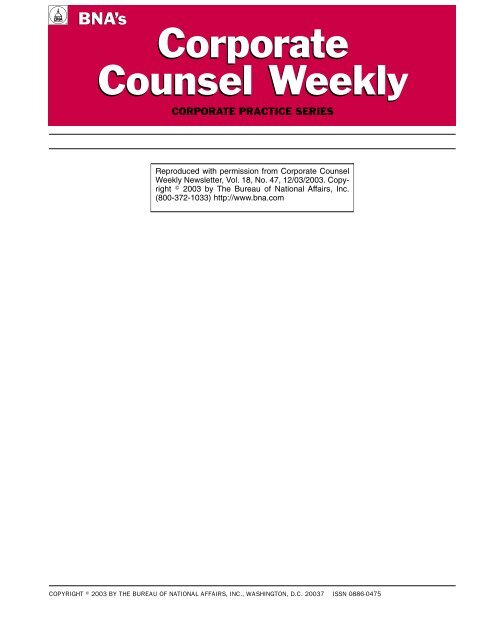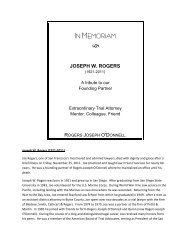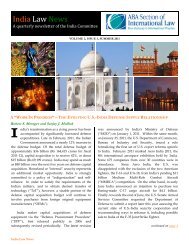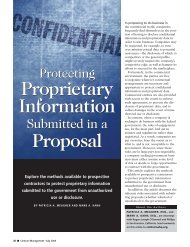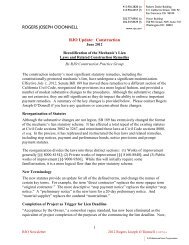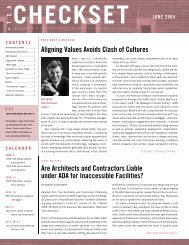Disabled Access Laws and the Internet - Rogers Joseph O'Donnell
Disabled Access Laws and the Internet - Rogers Joseph O'Donnell
Disabled Access Laws and the Internet - Rogers Joseph O'Donnell
Create successful ePaper yourself
Turn your PDF publications into a flip-book with our unique Google optimized e-Paper software.
A BNA’s<br />
Corporate<br />
Counsel Weekly<br />
CORPORATE PRACTICE SERIES<br />
Reproduced with permission from Corporate Counsel<br />
Weekly Newsletter, Vol. 18, No. 47, 12/03/2003. Copyright<br />
2003 by The Bureau of National Affairs, Inc.<br />
(800-372-1033) http://www.bna.com<br />
COPYRIGHT 2003 BY THE BUREAU OF NATIONAL AFFAIRS, INC., WASHINGTON, D.C. 20037 ISSN 0886-0475
2 (No. 0)<br />
Analysis<br />
Disability Discrimination<br />
<strong>Disabled</strong> <strong>Access</strong> <strong>Laws</strong> <strong>and</strong> <strong>Internet</strong> Websites—An Unsettled Area<br />
BY AARON P. SILBERMAN<br />
Editor’s Note: Mr. Silberman is a<br />
partner at <strong>the</strong> firm of <strong>Rogers</strong> <strong>Joseph</strong><br />
O’Donnell & Phillips in San<br />
Francisco, California. He specializes<br />
in disabled access, government contracts,<br />
<strong>and</strong> construction law.<br />
Federal law requires that public<br />
accommodations be accessible to<br />
persons with disabilities. Does this<br />
apply to websites? And, if so, what<br />
st<strong>and</strong>ards do businesses have to<br />
meet? In one area—sales of <strong>Internet</strong>based<br />
products to <strong>the</strong> federal<br />
government—<strong>the</strong>re are some answers<br />
under Section 508 of <strong>the</strong> Federal<br />
Rehabilitation Act <strong>and</strong> guidance<br />
issued under that section. In o<strong>the</strong>r<br />
public procurements <strong>and</strong> <strong>the</strong> commercial<br />
world, similar answers are<br />
likely to arrive soon.<br />
The U.S. Court of Appeals for <strong>the</strong><br />
Seventh Circuit (in dicta) <strong>and</strong> <strong>the</strong><br />
U.S. Department of Justice (‘‘<strong>the</strong><br />
DOJ’’) have taken <strong>the</strong> position that<br />
<strong>the</strong> Americans with Disabilities Act<br />
(‘‘<strong>the</strong> ADA’’) applies to commercial<br />
websites. Analogous case law from<br />
<strong>the</strong> First Circuit agrees. 1 On <strong>the</strong> o<strong>the</strong>r<br />
h<strong>and</strong>, at least one district court has<br />
expressly rejected a plaintiff’s attempt<br />
to sue a commercial website<br />
for alleged ADA violations. Analogous<br />
case law in <strong>the</strong> Third, Sixth, <strong>and</strong><br />
Ninth circuits <strong>and</strong> o<strong>the</strong>r district<br />
courts indicates that those courts<br />
would take a similar view.<br />
In this author’s opinion, <strong>the</strong> ADA<br />
is very likely to be applied to at least<br />
some types of websites. If <strong>and</strong> when<br />
courts apply <strong>the</strong> ADA to those websites,<br />
businesses can use Section 508<br />
as a model to predict what specific requirements<br />
will <strong>the</strong>n apply.<br />
1 For a comprehensive discussion of<br />
this issue, <strong>and</strong> an argument in favor of application<br />
of Title III of <strong>the</strong> ADA to websites,<br />
see When <strong>the</strong> Americans with Disabilities<br />
Act Goes Online: Application of<br />
<strong>the</strong> ADA to <strong>the</strong> <strong>Internet</strong> <strong>and</strong> <strong>the</strong> Worldwide<br />
Web, National Council on Disability,<br />
July 10, 2003, at http://www.ncd.gov/<br />
newsroom/publications/adainternet.html.<br />
Whe<strong>the</strong>r disabled access laws apply<br />
to a website depends on who<br />
owns <strong>and</strong> operates <strong>the</strong> site <strong>and</strong> may<br />
also depend on <strong>the</strong> types of services<br />
<strong>the</strong> site provides.<br />
To date, no court has held that<br />
commercial websites must be<br />
accessible to persons with<br />
disabilities.<br />
Who Owns <strong>the</strong> Site?<br />
Public Sector. Websites owned or<br />
operated by <strong>the</strong> federal government<br />
are subject to Section 508 of <strong>the</strong> Federal<br />
Rehabilitation Act (29 U.S.C.<br />
§ 794d), which requires that those<br />
sites be accessible to persons with<br />
disabilities. An increasing number of<br />
state <strong>and</strong> local governments are<br />
adopting Section 508 or similar st<strong>and</strong>ards<br />
as well. In addition, websites<br />
for o<strong>the</strong>r public facilities, such as<br />
public transportation systems, are<br />
subject to requirements under Title II<br />
of <strong>the</strong> ADA, <strong>and</strong> its implementing<br />
regulations, that public entities make<br />
‘‘adequate communications available,<br />
through accessible formats <strong>and</strong> technology,<br />
to enable users to obtain information<br />
<strong>and</strong> schedule service.’’<br />
[Martin v. Metropolitan Atlanta<br />
Rapid Transit Authority (MARTA),<br />
225 F. Supp. 2d 1362, 1377 (N.D. Ga.<br />
2002) (holding that MARTA’s website<br />
violated Title II of <strong>the</strong> ADA because it<br />
was not accessible to persons with visual<br />
impairments).]<br />
Private Sector. The private, commercial<br />
sector is generally subject to<br />
Title III of <strong>the</strong> ADA (42 U.S.C.<br />
§ 12101, et seq.). The ADA requires<br />
that ‘‘public accommodations’’ be<br />
made accessible to persons with disabilities<br />
unless doing so would fundamentally<br />
alter <strong>the</strong> goods or services<br />
provided or would be an undue burden.<br />
A place of public accommodation<br />
is covered by <strong>the</strong> act if it ‘‘affects<br />
commerce’’ (i.e., provides goods or<br />
services to <strong>the</strong> public) <strong>and</strong> falls within<br />
one of 12 enumerated categories<br />
listed at 42 U.S.C. § 12181(7)(C). The<br />
listed categories include places of exhibition<br />
or entertainment, sales or<br />
rental establishments, service establishments,<br />
places of public display or<br />
collection, places of recreation, <strong>and</strong><br />
places of education. Specific ADA access<br />
requirements <strong>and</strong> guidance on<br />
how a public accommodation can<br />
meet <strong>the</strong>se requirements are provided<br />
in regulations created by <strong>the</strong><br />
Architectural & Transportation Barriers<br />
Compliance Board (‘‘<strong>the</strong> <strong>Access</strong><br />
Board’’) <strong>and</strong> promulgated at 28<br />
C.F.R. § 36.101, et seq.<br />
It is unclear whe<strong>the</strong>r Title III of <strong>the</strong><br />
ADA would apply to commercial<br />
websites. Whe<strong>the</strong>r those laws apply<br />
will likely depend on <strong>the</strong> types of services<br />
<strong>the</strong> site provides. 2 To date, no<br />
court has held that commercial websites<br />
must be accessible to persons<br />
with disabilities.<br />
What Types of Services<br />
Does <strong>the</strong> Site Provide?<br />
Sites Providing <strong>Access</strong> to Physical<br />
Public Accommodations. A site that<br />
provides access to a physical place<br />
that itself qualifies as a public accommodation<br />
probably should be subject<br />
to disabled access law requirements.<br />
For example, a <strong>the</strong>ater’s website,<br />
(continued on page 374)<br />
2 If a website includes job postings, it<br />
would be subject to Title I of <strong>the</strong> ADA,<br />
which prohibits disability discrimination<br />
in employment. If a disabled job applicant<br />
found such a website to be inaccessible,<br />
<strong>the</strong> website owner might be obligated, at<br />
<strong>the</strong> applicant’s request, to modify <strong>the</strong> website<br />
as a reasonable accommodation.<br />
12-3-03 COPYRIGHT 2003 BY THE BUREAU OF NATIONAL AFFAIRS, INC., WASHINGTON, D.C. CCW ISSN 0886-0475
(No. 0) 3<br />
(continued from back page)<br />
which allows patrons to purchase<br />
tickets online, should be covered by<br />
<strong>the</strong> ADA. The reasoning is that, even<br />
if <strong>the</strong> websites <strong>the</strong>mselves are not<br />
public accommodations (an unsettled<br />
question discussed below), to <strong>the</strong> extent<br />
<strong>the</strong>y are inaccessible to persons<br />
with disabilities, <strong>the</strong>y are barriers to<br />
access to places that clearly are public<br />
accommodations, e.g., <strong>the</strong>aters,<br />
sports arenas, museums, etc.<br />
The Tenth Circuit recently applied<br />
this reasoning in an analogous situation.<br />
In Rendon v. Valleycrest Productions,<br />
Ltd., 294 F.3d 1279 (10th<br />
Cir. 2002), plaintiffs with visual <strong>and</strong><br />
upper torso mobility impairments<br />
sued <strong>the</strong> production company for <strong>the</strong><br />
game show, ‘‘Who Wants to Be a Millionaire?,’’<br />
alleging that <strong>the</strong> show’s<br />
‘‘fast finger’’ telephone dial-in system<br />
for selecting contestants was inaccessible<br />
to <strong>the</strong>m. The district court dismissed<br />
<strong>the</strong> claims, agreeing with <strong>the</strong><br />
defendants’ argument that <strong>the</strong> dial-in<br />
system was not covered by <strong>the</strong> ADA.<br />
The appeals court reversed, holding<br />
that <strong>the</strong> dial-in system was a barrier<br />
to access to participation in <strong>the</strong> game<br />
show, which took place in a public<br />
accommodation, i.e., a TV studio.<br />
The DOJ, <strong>the</strong> agency charged with<br />
enforcing <strong>the</strong> ADA’s access provisions,<br />
has taken a similar position regarding<br />
websites. [Policy Ruling,<br />
Sept. 9, 1996: ADA <strong>Access</strong>ibility Requirements<br />
Apply to <strong>Internet</strong> Web<br />
Pages, 10 NDLR 240 (also available<br />
at http://www.usdoj.gov/crt/foia/<br />
tal712.txt).]<br />
Sites Without a Connection to a<br />
Physical Place of Public Accommodation.<br />
Every website has a connection<br />
to a physical place in <strong>the</strong> sense that it<br />
is located on a server or servers in<br />
real space, but what if that is <strong>the</strong><br />
site’s only connection to a physical<br />
space? Does <strong>the</strong> ADA apply, for example,<br />
to amazon.com, <strong>the</strong> same way<br />
it applies to a bricks <strong>and</strong> mortar book<br />
store? What if <strong>the</strong> site is connected to<br />
a physical place that does not qualify<br />
as a public accommodation?<br />
<strong>Access</strong> Now, Inc. v. Southwest Airlines,<br />
Co., 227 F. Supp. 2d 1312, 1314<br />
(S.D. Fla. 2002), is directly on point.<br />
In that case, <strong>the</strong> district court granted<br />
defendant Southwest Airlines’ motion<br />
to dismiss plaintiffs’ claims that<br />
Southwest’s website violated Title III.<br />
Significantly, <strong>the</strong> court noted that <strong>the</strong><br />
plaintiffs could not argue that <strong>the</strong><br />
website denied <strong>the</strong>m access to aircraft<br />
because aircraft are explicitly<br />
exempt from Title III (42 U.S.C.<br />
§ 12181(10)). The court concluded<br />
that Title III does not apply to websites<br />
based primarily on <strong>the</strong> plain language<br />
in <strong>the</strong> title (42 U.S.C.<br />
§ 12181(7)) <strong>and</strong> <strong>the</strong> implementing<br />
regulations (28 C.F.R. §§ 36.101,<br />
36.104), which both define ‘‘places of<br />
public accommodation’’ in terms of<br />
‘‘physical, concrete places.’’<br />
The applicability of disabled<br />
access laws to commercial<br />
websites is unsettled, but legal<br />
challenges are sure to come.<br />
At least one court has taken <strong>the</strong><br />
position that <strong>the</strong> ADA does apply to<br />
websites. In Doe v. Mutual of Omaha<br />
Insurance Co., 179 F.3d 557 (7th Cir.<br />
1999), a case involving an ADA challenge<br />
to an insurance policy, <strong>the</strong><br />
court states:<br />
The core meaning of [Title III of <strong>the</strong><br />
ADA], plainly enough, is that <strong>the</strong><br />
owner or operator of a store, hotel, restaurant,<br />
dentist’s office, travel agency,<br />
<strong>the</strong>ater, Web site, or o<strong>the</strong>r facility<br />
(whe<strong>the</strong>r in physical space or in electronic<br />
space, . . .[citation omitted, emphasis<br />
added]) that is open to <strong>the</strong> public<br />
cannot exclude disabled persons<br />
from entering <strong>the</strong> facility <strong>and</strong>, once in,<br />
from using <strong>the</strong> facility in <strong>the</strong> same way<br />
that <strong>the</strong> nondisabled do.<br />
The DOJ has taken <strong>the</strong> same position.<br />
In Hooks v. OKBridge, 232 F.3d<br />
208 (5th Cir. 2000) (decision without<br />
published opin.), <strong>the</strong> plaintiff sued a<br />
commercial website on which customers<br />
can play bridge for a fee, alleging<br />
that his membership at <strong>the</strong> site<br />
was terminated because he has bipolar<br />
disorder. In an unpublished opinion,<br />
<strong>the</strong> U.S. District Court for <strong>the</strong><br />
Western District of Texas dismissed<br />
<strong>the</strong> case, ruling that a company providing<br />
services over <strong>the</strong> <strong>Internet</strong> is<br />
not a physical place of public accommodation<br />
under <strong>the</strong> ADA <strong>and</strong> that <strong>the</strong><br />
defendant was exempt from <strong>the</strong> ADA<br />
as a ‘‘private club.’’ On appeal, <strong>the</strong><br />
DOJ filed an amicus brief with <strong>the</strong><br />
Fifth Circuit arguing that public accommodations<br />
under Title III are not<br />
limited to companies providing services<br />
to customers at a physical location<br />
<strong>and</strong> that <strong>the</strong> entertainment or<br />
recreation services provided by<br />
OKBridge make it a place of public<br />
accommodation. [See DOJ Amicus<br />
Brief at http://www.usdoj.gov/crt/<br />
briefs/hooks.htm.]<br />
Several circuits have looked at <strong>the</strong><br />
broader issue of whe<strong>the</strong>r <strong>the</strong> ADA’s<br />
definition of public accommodation<br />
requires that it be a physical place in<br />
<strong>the</strong> context of employee health insurance<br />
plans. The courts are split, with<br />
<strong>the</strong> Third, Sixth, <strong>and</strong>, most recently,<br />
<strong>the</strong> Ninth circuits holding that a<br />
physical place is required, such that<br />
<strong>the</strong> challenged plans are not covered.<br />
The First Circuit, on <strong>the</strong> o<strong>the</strong>r h<strong>and</strong>,<br />
has held that a physical place is not<br />
required.<br />
Subscriber-Only Websites. A website<br />
that is accessible to subscribers only<br />
is analogous to a private club <strong>and</strong><br />
probably would not be covered. The<br />
district court dismissed <strong>the</strong> plaintiff<br />
in OKBridge in part because it considered<br />
<strong>the</strong> challenged website, a<br />
members-only gaming site, to be <strong>the</strong><br />
equivalent of a private club.<br />
Subscriber-only sites are also very<br />
similar to <strong>the</strong> digital cable service<br />
that <strong>the</strong> district court found not to be<br />
a ‘‘public accommodation’’ in Torres<br />
v. AT&T Broadb<strong>and</strong>, LLC, 158<br />
F. Supp. 2d 1035 (N.D. Cal. 2001).<br />
Some Courts Are Likely to Find That<br />
Websites Must Be <strong>Access</strong>ible. In sum,<br />
it is unclear whe<strong>the</strong>r websites are<br />
<strong>the</strong>mselves public accommodations<br />
under <strong>the</strong> ADA. The DOJ believes<br />
<strong>the</strong>y are, <strong>and</strong> it is likely that <strong>the</strong> First<br />
<strong>and</strong> Seventh circuits would agree. On<br />
<strong>the</strong> o<strong>the</strong>r h<strong>and</strong>, decisions by <strong>the</strong><br />
Third, Sixth, <strong>and</strong> Ninth circuits indicate<br />
those courts would be more<br />
likely to reject application of <strong>the</strong> ADA<br />
to websites without a meaningful<br />
connection to a physical place.<br />
It is clear that Congress did not<br />
have websites in mind when <strong>the</strong> ADA<br />
was enacted in 1990. However, applying<br />
<strong>the</strong> ADA to websites would serve<br />
<strong>the</strong> general purposes of that statute<br />
of making public commerce accessible<br />
to persons with disabilities.<br />
If <strong>Disabled</strong> <strong>Access</strong> <strong>Laws</strong> Apply to<br />
Websites, What Do They Require?<br />
Parties Liable Under <strong>Disabled</strong> <strong>Access</strong><br />
<strong>Laws</strong>. The ADA requirements apply to<br />
entities that own or operate public accommodations.<br />
Thus, if a website is a<br />
public accommodation, <strong>the</strong> party or<br />
parties that own <strong>and</strong> operate <strong>the</strong> site<br />
will be liable for any access violations<br />
of that site. While some cases also<br />
hold design professionals, such as architects,<br />
liable under <strong>the</strong> ADA, <strong>the</strong><br />
majority view is that <strong>the</strong>y are not directly<br />
liable under <strong>the</strong> Act. Regardless,<br />
such professionals still need to<br />
be concerned about access require-<br />
CORPORATE COUNSEL WEEKLY ISSN 0886-0475 BNA 12-3-03
4 (No. 0)<br />
ments due to indemnity obligations<br />
<strong>the</strong>y may have to site owners.<br />
ADA Regulations. The DOJ, as <strong>the</strong><br />
federal agency responsible for implementing<br />
<strong>the</strong> ADA, has promulgated<br />
detailed regulations on how a public<br />
accommodation must make architectural<br />
features accessible, but it has<br />
created no such regulations for websites<br />
or similar technologies. However,<br />
courts can look to detailed regulations<br />
applicable to federal government<br />
websites under Section 508 for<br />
guidance on what website features<br />
are or are not accessible (36 C.F.R.<br />
§ 1194.1, et seq.). Commercial guidelines,<br />
though not legally binding, are<br />
also available. [See, e.g., Web Content<br />
<strong>Access</strong>ibility Guidelines 1.0, at<br />
http://www.w3.org/TR/WCAG10/.]<br />
Section 508—Rehabilitation Act<br />
Section 508 provides a model for<br />
<strong>the</strong> future if <strong>and</strong> when o<strong>the</strong>r laws,<br />
like <strong>the</strong> ADA, are applied to commercial<br />
websites. It provides that agencies<br />
can only purchase electronic <strong>and</strong><br />
information technology (‘‘EIT’’) that<br />
provides access to government employees<br />
<strong>and</strong> members of <strong>the</strong> public<br />
with disabilities ‘‘comparable’’ to that<br />
provided to persons without disabilities.<br />
EIT must meet applicable accessibility<br />
st<strong>and</strong>ards of <strong>the</strong> <strong>Access</strong> Board<br />
at 36 C.F.R. Pt. 1194. [See also http://<br />
www.access-board.gov/sec508/<br />
508st<strong>and</strong>ards.htm.]<br />
Subpart A of <strong>the</strong> regulations defines<br />
<strong>the</strong> types of technology covered.<br />
The application section (Section<br />
1194.2) outlines <strong>the</strong> scope <strong>and</strong> coverage<br />
of <strong>the</strong> st<strong>and</strong>ards, providing that<br />
<strong>the</strong>y apply to EIT which is defined as<br />
‘‘any equipment or interconnected<br />
system or subsystem of equipment,<br />
that is used in <strong>the</strong> creation, conversion,<br />
or duplication of data or information.’’<br />
If no product meets all of<br />
<strong>the</strong> regulations’ accessibility st<strong>and</strong>ards,<br />
<strong>the</strong>n <strong>the</strong> agency may procure<br />
one that best meets st<strong>and</strong>ards (not<br />
necessarily <strong>the</strong> one that meets <strong>the</strong><br />
most st<strong>and</strong>ards). The regulations incorporate<br />
<strong>the</strong> concept of ‘‘equivalent<br />
facilitation,’’ which permits vendors<br />
to use designs or technologies that<br />
differ from those prescribed in <strong>the</strong><br />
st<strong>and</strong>ards so long as <strong>the</strong>y result in<br />
substantially equivalent or greater access<br />
(Section 1194.5); this effectively<br />
converts <strong>the</strong> accessibility st<strong>and</strong>ards<br />
into performance criteria.<br />
Subpart B provides ‘‘technical<br />
st<strong>and</strong>ards’’ regarding various categories<br />
of EIT, including Web-based<br />
intra- <strong>and</strong> <strong>Internet</strong> information <strong>and</strong><br />
applications (Section 1194.22). Many<br />
of <strong>the</strong> criteria provided ensure access<br />
for persons with visual impairments<br />
who rely on assistive technology such<br />
as screen readers <strong>and</strong> refreshable<br />
Braille displays. The st<strong>and</strong>ards require<br />
certain conventions such as<br />
verbal tags or identification of graphics<br />
<strong>and</strong> format devices, like frames,<br />
which are necessary so assistive devices<br />
can read <strong>the</strong>m for <strong>the</strong> user in a<br />
sensible way. The st<strong>and</strong>ards do not<br />
prohibit graphics or animation but,<br />
where used, require that <strong>the</strong> same information<br />
be available in accessible<br />
format, which generally means <strong>the</strong><br />
use of text labels or descriptors for<br />
graphics <strong>and</strong> certain format<br />
elements.<br />
Subpart C of <strong>the</strong> regulations provides<br />
functional performance criteria<br />
for technologies or components for<br />
which <strong>the</strong>re are no specific requirements<br />
under technical st<strong>and</strong>ards in<br />
Subpart B. For example, one provision<br />
requires that at least one mode<br />
allow operation by individuals with<br />
low vision (between 20/70 <strong>and</strong> 20/<br />
200) without relying on audio input<br />
(since those individuals may also<br />
have a hearing loss).<br />
Subpart D regulates information,<br />
documentation, <strong>and</strong> support, including<br />
user guides, installation guides,<br />
customer support, <strong>and</strong> tech support<br />
communications. Such items must be<br />
made available in alternative formats<br />
upon request at no additional charge.<br />
Alternative formats include Braille,<br />
cassette recordings, large print, electronic<br />
text, <strong>Internet</strong> postings, TTY access,<br />
<strong>and</strong> captioning <strong>and</strong> audio description<br />
for video materials.<br />
In addition to <strong>the</strong> formal regulations,<br />
<strong>the</strong> Section 508 interagency<br />
steering committee has issued detailed,<br />
informal guidance in <strong>the</strong> form<br />
of a ‘‘frequently asked questions’’<br />
document. 3<br />
How Can Websites Be Made More<br />
<strong>Access</strong>ible to <strong>Disabled</strong> Persons?<br />
If disabled access law requirements<br />
do apply to websites, <strong>the</strong>n how<br />
can site owners <strong>and</strong> operators make<br />
<strong>the</strong>ir sites more accessible?<br />
Persons with disabilities commonly<br />
encounter <strong>the</strong> following barriers<br />
to access in websites:<br />
s visual features (e.g., photos,<br />
graphics) with no text equivalents or<br />
special coding, including graphics essential<br />
to navigating site or imparting<br />
3 Available at http://<br />
www.section508.gov/<br />
index.cfm?FuseAction=Content&ID=75.<br />
vital information (such as a table or<br />
image map);<br />
s color cues (e.g., links that<br />
change from red to green once <strong>the</strong>y<br />
have been used); 4<br />
s text that is too small, has too<br />
little contrast, etc.;<br />
s audio or video features with no<br />
text equivalents, e.g., sounds to indicate<br />
<strong>the</strong> user has made a mistake;<br />
s features only accessible by typing<br />
in text;<br />
s features only accessible by<br />
mouse clicking on a target.<br />
<strong>Disabled</strong> persons can use many<br />
technologies effectively, including<br />
websites, through <strong>the</strong> use of adaptive<br />
equipment or software, also known<br />
as ‘‘assistive technology.’’ Examples<br />
of assistive technology include:<br />
s screen reader technology—<br />
allows persons with visual impairments<br />
to use websites by converting<br />
text to speech or refreshable Braille<br />
display,<br />
s voice recognition technology—<br />
allows persons with certain physical<br />
or dexterity impairments to input<br />
comm<strong>and</strong>s,<br />
s closed-captioning—allows persons<br />
with hearing impairments to follow<br />
audio content.<br />
Finally, websites can be made<br />
more accessible by providing accessible<br />
information about how to access<br />
website features (e.g., including an<br />
access instruction page for site visitors<br />
<strong>and</strong> providing help desk assistance<br />
knowledgeable about assistive<br />
technology <strong>and</strong> accessibility features<br />
of <strong>the</strong> site).<br />
Conclusion<br />
Every day, websites are becoming<br />
a more significant part of how we do<br />
business. This means that access barriers<br />
in sites are increasingly depriving<br />
disabled persons of this means of<br />
doing business. Businesses should<br />
consider <strong>the</strong> accessibility of <strong>the</strong>ir<br />
sites to <strong>the</strong> disabled, whe<strong>the</strong>r <strong>the</strong>y are<br />
legally obligated to do so or not. The<br />
applicability of disabled access laws<br />
to commercial websites is unsettled,<br />
but legal challenges are sure to come.<br />
And it is likely that when <strong>the</strong>y do, at<br />
least some courts will find <strong>the</strong> laws<br />
do apply to at least some sites.<br />
4 To check websites for readability by<br />
persons with some forms of colorblindness,<br />
visit http://www.vischeck.com.<br />
12-3-03 COPYRIGHT 2003 BY THE BUREAU OF NATIONAL AFFAIRS, INC., WASHINGTON, D.C. CCW ISSN 0886-0475


